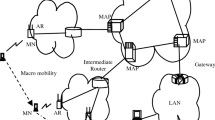Abstract
In the future, mobility support will require handling roaming in heterogeneous access networks. In order to enable seamless roaming it is necessary to minimize the impact of the vertical handoffs. Localized mobility management schemes such as Fast Handovers for Mobile IPv6 (FMIPv6) and Hierarchical Mobile IPv6 do not provide sufficient handoff performance, since they have been designed for horizontal handoffs. In this paper, we propose the SafetyNet protocol, which allows a Mobile Node to perform seamless vertical handoffs. Further, we propose the SafetyNet handoff timing algorithm, to enable a Mobile Node to delay or even completely avoid upward vertical handoffs. We implement the SafetyNet protocol and compare its performance with the FMIPv6 protocol in our wireless test bed and analyze the results. The experimental results indicate that the proposed SafetyNet protocol can provide an improvement of up to 95% for TCP performance in vertical handoffs, when compared with FMIPv6 and an improvement of 64% over FMIPv6 with bicasting. We use numerical analysis of the protocol to show that its over the air signaling and data transmission overhead is comparable to FMIPv6 and significantly smaller than that of FMIPv6 with bicasting.
Similar content being viewed by others
References
Bhaskara, G., & Helmy, A. (2004). TCP over micro-mobility protocols: Systematic ripple effect analysis. In Proceedings of IEEE vehicular technology Conference (VTC), Vol. 5, pp. 3095–3099.
Campbell, A., Gomez, J., Kim, S., & Wan, C. (2002). Comparison of ip micro-mobility protocols. IEEE Wireless Communications, 9(1), pp. 72–82.
Chakravorty, P., Vidales, K., Subramanian, I., Pratt, J., & Crowcroft, J. (2004). Performance Issues with vertical handovers–experiences from GPRS cellular and WLAN hot-spots integration. In Proceedings of the second IEEE annual conference on pervasive computing and communications, pp. 155–164.
fmipv6.org implementation of FMIPv6, http://www. fmipv6.org
Guo, Q., Zhu, J., & Xu, X. (2005). An adaptive multi-criteria vertical handoff decision algorithm for radio heterogeneous network. In Proceedings of ICC 2005, Vol. 4, pp. 2769–2773.
Hsieh, R., & Seneviratne, A. (2003) A comparison for improving mobile IP handoff latency for end-to-end TCP. In Proceedings of mobicom ’03: the 9th annual international conference of mobile computing and networking, San Diego, USA, pp. 29–41.
Katz, R. H. & Brewer, E. A. (1994). The case for wireless overlay networks. SPIE Multimedia and Networking Conference (MMNC’96), San Jose, CA, Jan. 29–30.
Kent, S., & Atkinson, R. (1998) IP authentication header. RFC 2402, Internet Engineering Taskforce.
Koodli, R.(Ed.). (2005) Fast handovers for mobile IPv6. RFC 4068, Internet Engineering Taskforce.
Lee C.W., et al. (2005). A framework of handoffs in wireless overlay networks based on mobile IPv6. IEEE Journal on Selected Areas in Communications 23(11): 2118–2128
Malki, K., & Soliman, H. (2002). Simultaneous bindings for mobile IPv6 fast handoffs. draft-elmalki-mobileip-bicasting-v6-06.txt, Internet Engineering Task Force, Work in Progress.
McNair J., Zhu F. (2004). Vertical handoffs in fourth-generation multinetwork environments. Wireless Communications 11(3): 8–15
Mohanty S., Akyildiz I.F. (2006). A cross-layer (Layer 2 + 3) handoff management protocol for next-generation wireless systems. IEEE Transactions on Mobile Computing 5(10): 1347–1360
Petander, H. (2006). Bicasting with buffering and selective delivery for fast handovers for mobile IPv6. draft-petander-mipshop-fmipv6-bbsd-00.txt, Internet Engineering Task Force, Work in Progress.
Soliman, H., Castelluccia, C., El-Malki, K., & Bellier, L. (2002). Hierarchical mipv6 mobility management. draft-ietf-mipshop-hmipv6-04.txt, Internet Engineering Task Force.
Petander, H. (2006). Optimizing localized mobility management for make-before-break handoffs. In. Proceedings of the NEWCOM-ACoRN Joint Workshop, Vienna, Austria, Sept 20–22.
Vidales P., et al. (2005). Autonomic system for mobility support in 4G networks. IEEE Journal on Selected Areas in Communications 23(12): 2288–2304
Zhang Q., et al. (2003). Efficient mobility management for vertical handoff between WWAN and WLAN. IEEE Communications Magazine 41(11): 102–108
Author information
Authors and Affiliations
Corresponding author
Rights and permissions
About this article
Cite this article
Petander, H., Perera, E. & Seneviratne, A. Multicasting with selective delivery: a SafetyNet for vertical handoffs. Wireless Pers Commun 43, 945–958 (2007). https://doi.org/10.1007/s11277-007-9258-3
Received:
Accepted:
Published:
Issue Date:
DOI: https://doi.org/10.1007/s11277-007-9258-3




